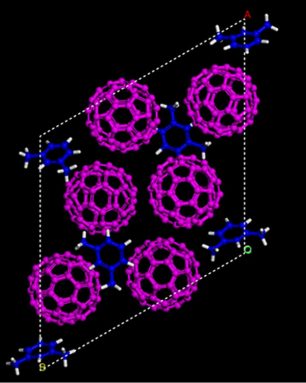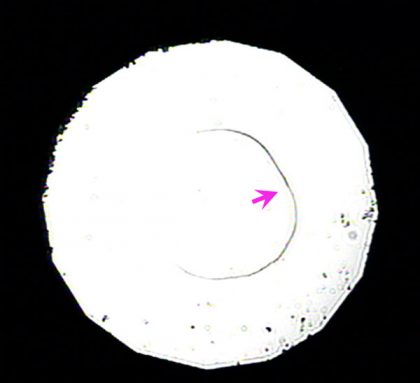Harder than diamonds?
Researchers create new material that may be world’s hardest
By Sid Perkins

Diamonds have long been considered the world’s hardest material. Scrape one across any surface, and it will leave a scratch. Press one into any surface, and it will make a dent. But the prized mineral’s record status now appears in peril: Researchers have created a new material that may be even harder than diamond.
Key to the team’s success: Pressure. Lots of it, explains Lin Wang, who works for the Carnegie Institution of Washington in Argonne, Ill. As a materials scientist, Lin studies how the structure of materials at the atomic and molecular scale relates to their overall properties.
To make the superhard substance, his team began with carbon molecules called fullerenes. Each molecule contains 60 carbon atoms arranged in a pattern that resembles a ball-shaped cage. In fact, if you were to draw a fullerene molecule and also draw all of the chemical bonds that hold its atoms together, each fullerene would look just like a soccer ball.

The researchers then added a carbon-rich liquid called xylene to the fullerenes. The carbon atoms in each xylene molecule are arranged in a ring. Xylene molecules weakly link to the fullerenes and so helped keep those ball-shaped molecules spaced a certain distance apart, Wang explains.
Finally, the researchers put the combo into a machine called a diamond anvil cell. Made from two tiny, flat pieces of polished diamond, it could squeeze the fullerene-xylene mixture at very high pressures. The anvil’s squeeze on that new material exerted about 320,000 times the pressure that Earth’s atmosphere exerts at sea level. That’s about the same pressure as the weight of 300 elephants on a single postage stamp! The result: The fullerene cages began to collapse and break apart. That created a new structure that became exceptionally dense and hard, Wang explains.
When the researchers took the samples out of their diamond anvil cell, they noticed that the tiny diamonds that had been used to squeeze the samples were cracked. That’s a clue that the compressed version of the fullerene-xylene mixture is harder than diamond, Wang and his coworkers reported in the Aug. 17 issue of the journal Science. Current computer analyses of materials can’t help estimate how hard the new material is compared with diamond, so for now only tests of actual samples can reveal the answer.
“We don’t know what the properties of the new material are,” says Bertil Sundqvist, a physicist at Umeå University in Sweden who did not work on the study.
Even though the sample of compressed fullerene-xylene material dented the flat pieces of diamond, it’s possible that the material is slightly softer than diamond (but still very hard), he notes. The material might have made dents in the pieces of diamond simply because there was a gap in the diamond anvil cell that created extra stress at the edge of some portions of the sample, he adds.
The samples of superhard material that Wang and his team created are very small — no more than 200 micrometers across, or a distance about twice the thickness of a sheet of paper. “We’d need different equipment to make larger samples,” says Wang. So it’s too soon to begin envisioning amazingly tough tools, such as ever-sharp saw blades or super-heavy-duty sandpaper, based on the new material.
Power Words
atom The smallest possible bit of a chemical element. Atoms are made up of a dense nucleus (which contains positively charged protons and neutrally charged neutrons) that is orbited by a cloud of negatively charged electrons. Because atoms are neutrally charged overall, the number of protons inside the nucleus must equal the atom’s number of electrons.
atomic number The number of protons in an atomic nucleus, which determines the type of atom and how it behaves.
carbon A chemical element with an atomic number of six. Carbon, one of the most common elements in the universe, takes many forms, including diamond, graphite (the substance in pencil lead) and coal. Carbon forms more chemical compounds than any other element, and it also is present in all known life-forms.
diamond anvil cell A piece of equipment that researchers use to squeeze samples of material at very high pressure. Samples are typically sandwiched between tiny, flat pieces of diamond. Because diamonds are very hard, pressures inside the samples can reach very high levels. Scientists often squeeze tiny samples of minerals inside diamond anvil cells to see how they might behave deep inside Earth or on other planets.
fullerenes Molecules of carbon that resemble tiny, soccer ball–like cages when the chemical bonds between all of the carbon atoms are drawn. Fullerenes, which chemists first created in 1985, are nicknamed “buckyballs” after Buckminster Fuller, the famous architect and engineer who designed dome-shaped structures that resemble fullerene molecules.
materials scientist A scientist who studies how the atomic and molecular structure of a material is related to its overall properties. Materials scientists can design new materials or analyze existing ones. Their analyses of a material’s overall properties (such as density, melting point, etc.) can help engineers and other researchers select materials that are appropriate for a particular purpose.
molecule An electrically neutral group of atoms that represents the smallest possible bit of a chemical compound. Molecules can be made of single types of atoms or of many different types. For example, the oxygen in the air is made of two oxygen atoms (O2), but water is made of two hydrogen atoms and one oxygen atom (H2O).







